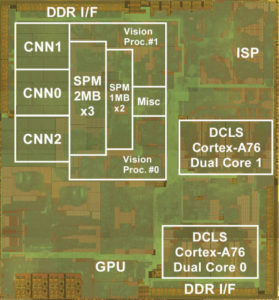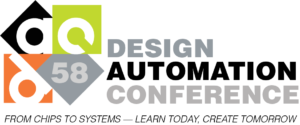
EDACafe Editorial Roberto Frazzoli
Roberto Frazzoli is a contributing editor to EDACafe. His interests as a technology journalist focus on the semiconductor ecosystem in all its aspects. Roberto started covering electronics in 1987. His weekly contribution to EDACafe started in early 2019. Concerns over Nvidia-Arm deal; ISSCC innovations; DAC postponed to DecemberFebruary 22nd, 2021 by Roberto Frazzoli
As Alphabet-owned Waymo expands testing of its autonomous vehicles in San Francisco, automotive vision startup Recogni raises $48.9 million in a Series B financing round. The autonomous vehicle landscape seems to be evolving quickly – and it will be interesting to see if this will have an impact on Mobileye, under the new Intel CEO. Let’s now move to some weekly news updates. Qualcomm, Google and Microsoft reportedly against Nvidia-Arm deal According to a report from CNBC, Qualcomm has told regulators around the world that it is against Nvidia’s acquisition of Arm. Qualcomm reportedly complained to the U.S. Federal Trade Commission, the European Commission, the U.K.’s Competition and Markets Authority and China’s State Administration for Market Regulation. The FTC’s investigation has reportedly moved to a “second phase” and the U.S. regulator has asked SoftBank (current Arm owner), Nvidia and Arm to provide it with more information. According to a report from Bloomberg, the list of companies complaining to U.S. antitrust regulators about Nvidia’s acquisition of Arm also includes Google and Microsoft. Both CNBC and Bloomberg reports are based on sources who asked not to be identified. Commenting these reports on EETimes, analyst Mike Feibus noted that “not a single Big Tech exec has spoken out publicly against [the Nvidia-Arm deal]”. Feibus also pointed out that the execs he has spoken with over the past few months “say the outcome they fear most is that they might set themselves up for retribution by Nvidia if they object to the acquisition, and the deal is consummated anyway.” New Arm records Meanwhile, the value and importance of Arm is reflected in its recently announced results: in the third quarter of 2020 alone, Arm silicon partners shipped 6.7 billion Arm-based chips. Most of them – 4.4 billion – are based on Cortex-M; another key contributor was the Mali graphics processor, which – according to Arm – remains the number one shipping GPU. In calendar year 2020, Arm signed 175 new licenses, bringing the total to 1,910 licenses and 530 licensees.
Innovations from ISSCC 2021: Kioxia, Samsung, Renesas The 2021 International Solid-State Circuits Virtual Conference has just finished. Let’s take a look at three of the innovations that have been introduced at the event. Kioxia and Western Digital presented their sixth-generation, 162-layer 3D flash memory technology featuring innovations in vertical as well as lateral scaling to achieve greater capacity in a smaller die with fewer layers. The new architecture enables a 40 percent reduction in die size compared to the 112-layer stacking technology, optimizing cost. The Kioxia and Western Digital teams also applied Circuit Under Array CMOS placement and four-plane operation, which together deliver nearly 2.4 times improvement in program performance and an improvement in read latency compared to the previous generation. I/O performance also improves by 66 percent, enabling faster transfer rates. Overall, the new 3D flash memory technology increases the manufactured bits per wafer by 70 percent, compared with the previous generation. Samsung introduced what it claims to be the industry’s first High Bandwidth Memory integrated with artificial intelligence processing power — dubbed HBM-PIM, where PIM stands for processing-in-memory. The HBM-PIM brings processing power directly to where the data is stored by placing a DRAM-optimized AI engine inside each memory bank — a storage sub-unit — enabling parallel processing and minimizing data movement. Samsung claims that – when applied to the company’s existing HBM2 Aquabolt solution – the new architecture is able to deliver over twice the system performance while reducing energy consumption by more than 70%. The HBM-PIM also does not require any hardware or software changes. Renesas presented R-Car V3U, a new automotive SoC for ADAS and autonomous driving systems, featuring a convolutional neural network hardware accelerator core that delivers 60.4 TOPS and a power efficiency of 13.8 TOPS/W. The SoC also includes safety mechanisms for fast detection of and response to random hardware failures, and a mechanism that allows software tasks with different safety levels to operate in parallel on the SoC without interfering with each other, thus supporting functional safety for ASIL D control. Renesas points out that achieving freedom from interference (FFI) between software tasks is an important aspect of meeting functional safety standards. When software components with different safety levels are present in the system, it is essential to prevent lower-level tasks from causing dependent failures in higher-level tasks. In addition, an issue of particular importance in SoCs is ensuring FFI when accessing control registers in various hardware modules and shared memory. Renesas has developed an FFI support mechanism that monitors all data flowing through interconnects in the SoC and blocks unauthorized access between tasks. This makes possible to comply to ASIL D and implement multiple functions with a single chip. Acquisitions Analog Devices has acquired the wireless assets of Comcores, a European IP supplier – with offices in Denmark and Poland – whose product portfolio includes IP that can be used in O-RAN applications. According to a press release, the deal is part of Analog Devices’ O-RAN strategy. Keysight has completed the acquisition of Sanjole, a Hawaii-based provider of solutions for protocol decoding and interoperability of 4G, 5G and other wireless technologies. Events The SPIE Advanced Lithography conference is taking place as a virtual event from February 22 to 26. The digital forum encompasses eight conferences, devoted to Extreme Ultraviolet Lithography; Novel Patterning Technologies; Metrology, Inspection, and Process Control for Semiconductor Manufacturing; Advances in Patterning Materials and Processes; Optical Lithography; Design-Technology Co-optimization; Advanced Etch Technology and Process Integration for Nanopatterning; Advanced Lithography Product Demos. The Design Automation Conference has been postponed to December 5-9, 2021, hoping to facilitate the return to face-to-face networking. The 58th DAC will be held at Moscone West Center in San Francisco, CA, co-located with Semicon West 2021, which is being held December 7-9 at Moscone North and South halls. |
|
|
|||||
|
|
|||||
|
|||||









